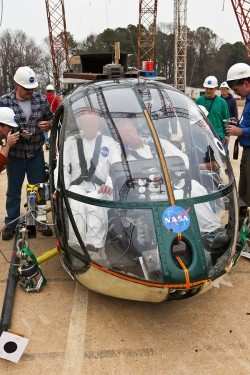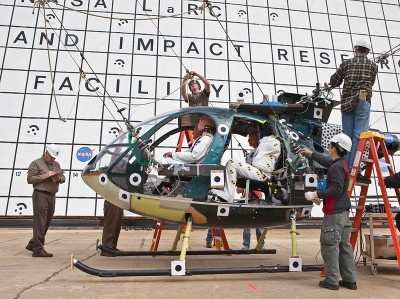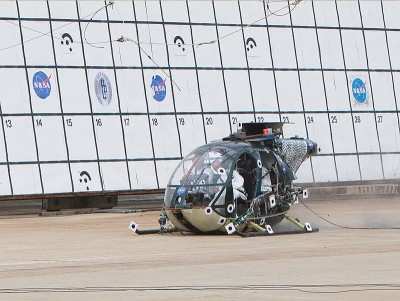This Time, Helo Fuselage Was Dropped Without The 'Airbag'
A second crash test of a small lightweight helicopter at NASA's
Langley Research Center in Hampton, VA, produced the results that
engineers expected ... the aircraft was badly damaged and the
occupants would have suffered severe injuries.

NASA Photo
The helicopter fuselage was dropped from a height of 35 feet at
a steep angle of descent. It smacked hard into the concrete, the
skid gear collapsed, its windscreen cracked open and its occupants
lurched forward violently, suffering potentially spine-crushing
injuries according to internal data recorders. The crash test was
all in the name of research to try to make helicopters safer.
"The goal of any research program that has an element of impact
dynamics is to develop an understanding of the crash response of
the vehicle," said Karen Jackson, an aerospace engineer who oversaw
the test. "Once we understand that response we can look at ways to
improve the crash performance."

NASA Photo
In December 2009
researchers dropped the same MD-500 fuselage at a similar angle
from the same height. Inside were the same instruments that
collected 160 channels of data and the same four crash test
dummies. Three of the dummies were full bodies and one was a
special torso model equipped with simulated internal organs.
Technicians set up the same cameras to record the impact from
inside and outside the helicopter. But in the first test, the
MD-500 skidded to a stop, with very little damage to the helicopter
or its silent occupants, because its underside was outfitted with
an expandable honeycomb cushion called a deployable energy
absorber.
"It's made of Kevlar and has a unique flexible hinge design that
allows the honeycomb to be packaged and remain flat until needed,"
said Sotiris Kellas, the Langley engineer who created the idea as a
way to cushion the next generation of astronaut-carrying space
capsules, but realized it could be used in other ways.
The test conditions on both days were the same, simulating what
would be a relatively severe but survivable helicopter crash. The
flight path angle was about 33 degrees and the combined forward and
vertical speeds were about 48 feet per second or 33 miles per
hour.

NASA Photo
The more recent drop test on March 10 involved just the
helicopter. No new technology was attached, and that was the point.
Engineers wanted to determine exactly how efficient the deployable
energy absorber had been in the earlier test and how much it might
help reduce occupant injuries. So they dropped the same helicopter
in the same way and measured and recorded the same conditions with
the same instruments.
"We were fortunate enough that the helicopter survived so well
the first time that we could use it again," said engineer Martin
Annett.
There will be no third crash test for this helicopter.
Researchers say the "g" forces the MD-500 experienced more than
tripled those recorded in the previous test, and the aircraft was
too badly damaged. But engineers still have gigabytes of data to
analyze to confirm exactly what impact the new honeycomb cushion
technology might have for helicopters in the future.
The drop tests were conducted by the Subsonic Rotary Wing
Project of NASA's Fundamental Aeronautics Program, and funded by
the agency's Aeronautics Research Mission Directorate in
Washington.
 ANN's Daily Aero-Term (05.01.24): Say Altitude
ANN's Daily Aero-Term (05.01.24): Say Altitude ANN's Daily Aero-Linx (05.01.24)
ANN's Daily Aero-Linx (05.01.24) Classic Aero-TV: Korean War Hero Twice Reborn
Classic Aero-TV: Korean War Hero Twice Reborn Airborne 04.29.24: EAA B-25 Rides, Textron 2024, G700 Deliveries
Airborne 04.29.24: EAA B-25 Rides, Textron 2024, G700 Deliveries Airborne Affordable Flyers 05.02.24: Bobby Bailey, SPRG Report Cards, Skydive!
Airborne Affordable Flyers 05.02.24: Bobby Bailey, SPRG Report Cards, Skydive!





